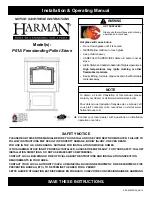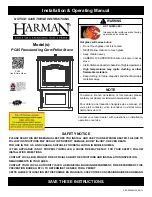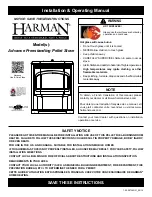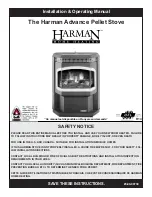
-7-
VENT TERMINATION CLEARANCES
A.
Minimum 4-foot (1.22m) clearance
below or beside any door or window
that opens.
B.
Minimum 1-foot (0.3m) clearance
above any door or window that opens.
C.
Minimum 3-foot (0.91m) clearance
from any adjacent building.
D.
Minimum 7-foot (2.13m) clearance
from any grade when adjacent to
public walkways.
E.
Minimum 2-foot (0.61m) clearance
above any grass, plants, or other
combustible materials.
F.
Minimum 3-foot (0.91m) clearance
from an forced air intake of any
appliance.
G. Minimum 2-foot (0.61m) clearance
below eves or overhang.
H.
Minimum 1-foot (0.3m) clearance horizontally from combustible wall.
I.
Must be a minimum of 3 foot (0.91m) above the roof and 2 foot (0.61m) above the highest point or the roof
within 10 feet (3.05m).
G
Figure 6
Vent Termination Clearances
THROUGH THE WALL INSTALLATION
(RECOMMENDED
INSTALLATION)
Canadian installations must conform to CAN/CSA-B365. To
vent the unit through the wall, connect the pipe adapter to
the exhaust motor adapter. If the exhaust adapter is at least
18 in.(457mm) above ground level, a straight section of pellet
vent pipe can be used through the wall. Your heater dealer
should be able to provide you with a kit that will handle most
of this installation, which will include a wall thimble that will
allow the proper clearance through a combustible wall.
Once outside the structure, a 3 in.(76mm) clearance should
be maintained from the outside wall and a clean out tee
should be placed on the pipe with a 90-degree turn away
from the house. At this point, a 3ft (0.91m) (minimum) section
of pipe should be added with a horizontal cap, which would
complete the installation (see FIGURE 7). A support bracket
should be placed just below the termination cap or one
every 4ft (1.22m) to make the system more stable. If you
live in an area that has heavy snowfall, it is recommended
that the installation be taller than 3ft (0.91m) to get above
the snowdrift line. This same installation can be used if your
heater is below ground level by simply adding the clean-out
section and vertical pipe inside until ground level is reached.
With this installation you have to be aware of the snowdrift
line, dead grass, and leaves. We recommend a 3ft (0.91m)
minimum vertical rise on the inside or outside of the house.
The “through the wall” installation is the least expensive and
simplest installation. Never terminate the end vent under a deck, in an alcove, under a window, or between two
windows. We recommend Simpson Dura-Vent® or Metal-Fab® kits.
THROUGH THE ROOF/CEILING INSTALLATION
When venting the heater through the ceiling, the pipe is connected the same as through the wall, except the
clean-out tee is always on the inside of the house, and a 3 in.(76mm) adapter is added before the clean-out tee.
You must use the proper ceiling support flanges and roof flashing (supplied by the pipe manufacturer; follow the
pipe manufacturer’s directions). It is important to note that if your vertical run of pipe is more than 15ft (4.57m),
the pellet vent pipe size should be increased to 4 in. (102mm) in diameter.
Do not exceed more than 4ft (1.22m) of pipe on a horizontal run and use as few elbows as possible. If an offset
is required, it is better to install 45-degree elbows rather than 90-degree elbows.
Figure 7
Typical Through The Wall Installation
Содержание KP130
Страница 2: ......
Страница 22: ...20 9 3 2 1 5 6 4 7 8 10 Parts Diagram 47 46 48 49 50...
Страница 27: ...20 Sch ma des pi ces 9 3 2 1 5 6 4 7 8 10 47 46 48 49 50...










































